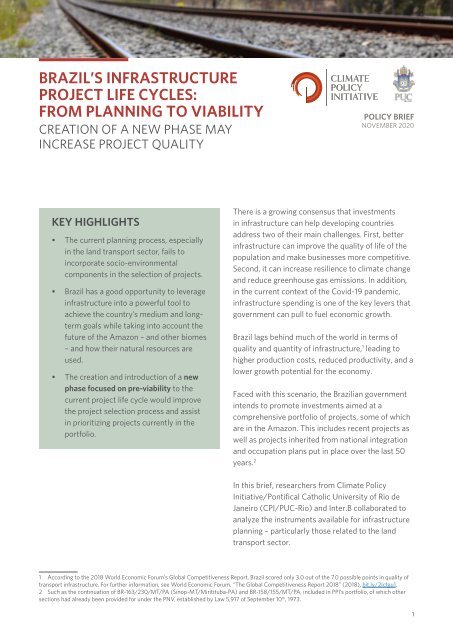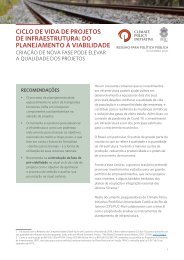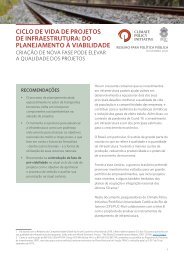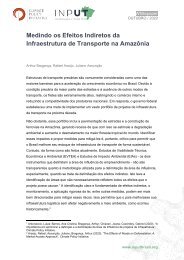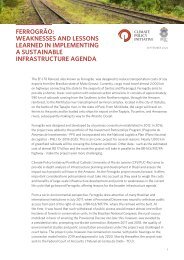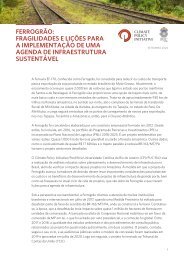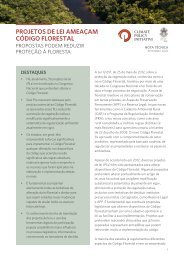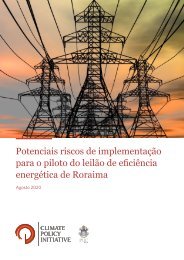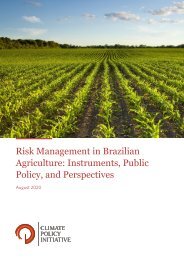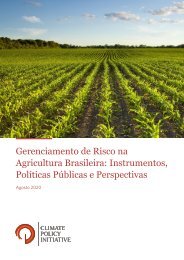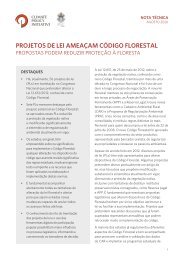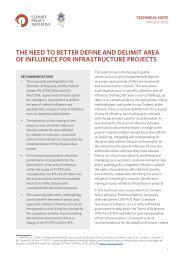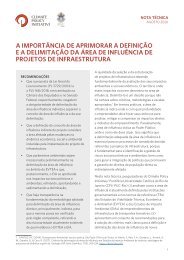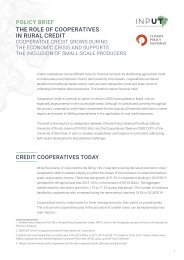Brazil’s Infrastructure Project Life Cycles: from Planning to Viability. Creation of a New Phase May Increase Project Quality
You also want an ePaper? Increase the reach of your titles
YUMPU automatically turns print PDFs into web optimized ePapers that Google loves.
BRAZIL’S INFRASTRUCTURE<br />
PROJECT LIFE CYCLES:<br />
FROM PLANNING TO VIABILITY<br />
CREATION OF A NEW PHASE MAY<br />
INCREASE PROJECT QUALITY<br />
POLICY BRIEF<br />
NOVEMBER 2020<br />
KEY HIGHLIGHTS<br />
• The current planning process, especially<br />
in the land transport sec<strong>to</strong>r, fails <strong>to</strong><br />
incorporate socio-environmental<br />
components in the selection <strong>of</strong> projects.<br />
• Brazil has a good opportunity <strong>to</strong> leverage<br />
infrastructure in<strong>to</strong> a powerful <strong>to</strong>ol <strong>to</strong><br />
achieve the country’s medium and longterm<br />
goals while taking in<strong>to</strong> account the<br />
future <strong>of</strong> the Amazon – and other biomes<br />
– and how their natural resources are<br />
used.<br />
• The creation and introduction <strong>of</strong> a new<br />
phase focused on pre-viability <strong>to</strong> the<br />
current project life cycle would improve<br />
the project selection process and assist<br />
in prioritizing projects currently in the<br />
portfolio.<br />
There is a growing consensus that investments<br />
in infrastructure can help developing countries<br />
address two <strong>of</strong> their main challenges. First, better<br />
infrastructure can improve the quality <strong>of</strong> life <strong>of</strong> the<br />
population and make businesses more competitive.<br />
Second, it can increase resilience <strong>to</strong> climate change<br />
and reduce greenhouse gas emissions. In addition,<br />
in the current context <strong>of</strong> the Covid-19 pandemic,<br />
infrastructure spending is one <strong>of</strong> the key levers that<br />
government can pull <strong>to</strong> fuel economic growth.<br />
Brazil lags behind much <strong>of</strong> the world in terms <strong>of</strong><br />
quality and quantity <strong>of</strong> infrastructure, 1 leading <strong>to</strong><br />
higher production costs, reduced productivity, and a<br />
lower growth potential for the economy.<br />
Faced with this scenario, the Brazilian government<br />
intends <strong>to</strong> promote investments aimed at a<br />
comprehensive portfolio <strong>of</strong> projects, some <strong>of</strong> which<br />
are in the Amazon. This includes recent projects as<br />
well as projects inherited <strong>from</strong> national integration<br />
and occupation plans put in place over the last 50<br />
years. 2<br />
In this brief, researchers <strong>from</strong> Climate Policy<br />
Initiative/Pontifical Catholic University <strong>of</strong> Rio de<br />
Janeiro (CPI/PUC-Rio) and Inter.B collaborated <strong>to</strong><br />
analyze the instruments available for infrastructure<br />
planning – particularly those related <strong>to</strong> the land<br />
transport sec<strong>to</strong>r.<br />
1 According <strong>to</strong> the 2018 World Economic Forum’s Global Competitiveness Report, Brazil scored only 3.0 out <strong>of</strong> the 7.0 possible points in quality <strong>of</strong><br />
transport infrastructure. For further information, see World Economic Forum, “The Global Competitiveness Report 2018” (2018), bit.ly/2Icfgu1.<br />
2 Such as the continuation <strong>of</strong> BR-163/230/MT/PA (Sinop-MT/Miritituba-PA) and BR-158/155/MT/PA, included in PPI’s portfolio, <strong>of</strong> which other<br />
sections had already been provided for under the PNV, established by Law 5,917 <strong>of</strong> September 10 th , 1973.<br />
1
The analysis found that there is an opportunity <strong>to</strong> (i) enact a planning strategy that reflects a<br />
sustainable development model and includes decisions about the future <strong>of</strong> the Amazon and other<br />
biomes, and (ii) <strong>to</strong> introduce a pre-viability phase <strong>to</strong> improve the project selection process and<br />
assist in prioritizing projects currently in the portfolio.<br />
This analysis reveals that the newly enacted Brazilian National Development Strategy (Estratégia<br />
Federal de Desenvolvimen<strong>to</strong> para o Brasil – EFD), 3 despite stating that it is a long-term strategy, is<br />
actually a medium-term one given its eleven-year time period. Additionally, while it establishes<br />
general key index and target goals, they may not be enough <strong>to</strong> address critical issues, such as<br />
deforestation.<br />
Based on this analysis, the authors recommend the introduction <strong>of</strong> a planning strategy that<br />
reflects a sustainable development model and the demand for infrastructure services and<br />
underlying assets for the medium and long-term. The Amazon deserves a special chapter in such<br />
a strategy, given its position as the largest tropical forest in the world and its role as a provider <strong>of</strong><br />
essential ecosystem services for <strong>Brazil’s</strong> economy and society at large.<br />
To ensure greater integrity in the project selection process, the authors<br />
recommend introducing a new step between the planning and the viability<br />
analysis <strong>of</strong> large-scale greenfield infrastructure projects. They propose the<br />
creation <strong>of</strong> a pre-viability phase that would act as a filter <strong>to</strong> ensure that only<br />
viable projects move forward, avoiding an au<strong>to</strong>matic track between planning<br />
and viability phases. In addition, the proposed pre-viability stage would be<br />
instrumental in helping prioritize the projects in the current portfolio.<br />
OVERVIEW OF INFRASTRUCTURE PLANNING<br />
INSTRUMENTS<br />
The Federal Constitution states that a law should be drafted <strong>to</strong> “set the guidelines and basis for<br />
the planning <strong>of</strong> a balanced development process at the national level, which should incorporate<br />
and ensure compatibility with national and regional development plans”. 4 Such law, however,<br />
does not yet exist.<br />
In view <strong>of</strong> this, other instruments are currently used <strong>to</strong> indicate the Federal Government’s<br />
short and medium-term plans – particularly the recently enacted EFD, as well as plans drafted<br />
by sec<strong>to</strong>ral bodies and entities and budgetary instruments, mainly the Multi-Year Plan (Plano<br />
Plurianual – PPA).<br />
A brief description <strong>of</strong> existing national planning instruments is provided below.<br />
3 Federal Decree 10,531/2020, accessed November 6, 2020, bit.ly/2GPy1Ti.<br />
4 Art. 174, § 1, accessed <strong>May</strong> 13, 2020, bit.ly/38stzoE. The law shall establish the guidelines and basis for planning <strong>of</strong> the balanced national<br />
development, which shall embody and make the national and regional development plans compatible.<br />
2
BRAZILIAN NATIONAL DEVELOPMENT STRATEGY (EFD)<br />
The EFD is a medium-term planning instrument <strong>from</strong> 2020 <strong>to</strong> 2031. It comprises five dimensions:<br />
economic, institutional, infrastructure, environmental, and social. It replaced the National<br />
Strategy for Economic and Social Development (Estratégia Nacional de Desenvolvimen<strong>to</strong> Econômico<br />
e Social – ENDES) that also set a national strategy for the same period but was never published as<br />
an <strong>of</strong>ficial norm.<br />
The EFD maintained a very similar structure as the ENDES, identifying most <strong>of</strong> the same<br />
challenges and solutions. While the ENDES lacked any tangible parameters <strong>to</strong> ensure the<br />
strategy assessment, the EFD advanced by establishing general key indices and respective target<br />
goals for each dimension. By setting these key indices, however, the EFD may also fall short on<br />
some specific issues by failing <strong>to</strong> include deforestation and biomes sensitivities, critical fac<strong>to</strong>rs<br />
for assessing infrastructure in the Amazon.<br />
As a guiding document that focuses on macro-level issues, it does not include specific<br />
infrastructure projects or criteria for project selection; multi-year plans, annual budget laws, and<br />
sec<strong>to</strong>ral plans are responsible for including them.<br />
3
BOX 1. INFRASTRUCTURE DEVELOPMENT IN THE AMAZON<br />
The EFD sets “reducing illegal deforestation” as a challenge <strong>to</strong> be overcome by the Brazilian<br />
government, but it makes no explicit mention <strong>of</strong> the Amazon. Domestic and foreign inves<strong>to</strong>rs,<br />
however, understand the importance <strong>of</strong> the region and the ecosystem services it provides, and<br />
they have taken public stances vis-à-vis investment prospects in the region and in the country. 5,6,7<br />
Over recent years, a growing international movement has sought <strong>to</strong> define a development<br />
pathway with a socio-environmental focus. In 2019, the G-20 General Assembly approved<br />
voluntary recommendations for quality infrastructure with reference <strong>to</strong> socio-environmental<br />
principles, 8 and in January 2020 the World Economic Forum recognized sustainability as its<br />
core element. 9 Generally speaking, in 2020 the sustainability imperative in the social and<br />
environmental sphere has become part <strong>of</strong> the mainstream for businesses, inves<strong>to</strong>rs, political and<br />
economic leaders, and, more importantly, for new generations.The Amazon features prominently<br />
in global commitments and concerns. For Brazil, which is home <strong>to</strong> approximately 60% <strong>of</strong> the<br />
Amazon basin and has seen its deforestation rates grow, 10 the Amazon is a major focus <strong>of</strong><br />
policies for preserving the region <strong>from</strong> a socio-environmental standpoint. Therefore, controlling<br />
deforestation is not just crucial, it is also an objective <strong>to</strong> be achieved under the country’s<br />
international climate commitments 11 and its National Climate Change Policy 12 .<br />
<strong>Infrastructure</strong> services that provide water, sanitation, health, mobility, and electricity at the local<br />
level are essential for the people who inhabit the Amazon. The existence <strong>of</strong> local infrastructure<br />
also encourages farmers <strong>to</strong> adopt intensive land use practices by lowering transportation<br />
costs for inputs and products, and by providing access <strong>to</strong> technical assistance and electricity<br />
for potential processing operations, in addition <strong>to</strong> fostering a bioeconomy. As is well known,<br />
however, large infrastructure projects were one <strong>of</strong> the biggest drivers <strong>of</strong> deforestation in the<br />
Amazon in the past. Over 80% <strong>of</strong> forest conversions occurred along roads. 13,14 In addition, the<br />
road, energy, and mining sec<strong>to</strong>rs located in the Amazon basin, <strong>to</strong>gether, threaten more than 50%<br />
<strong>of</strong> all protected areas, including Conservation Units and Indigenous Lands. 15<br />
This is, therefore, an opportunity <strong>to</strong> reflect upon a development strategy for the country, with<br />
infrastructure as a powerful instrument <strong>to</strong> achieve national goals, while considering the future <strong>of</strong><br />
the Amazon and the way its natural resources are used.<br />
5 Gabriel Shinohara, “Em Carta, Ex-Ministros e Ex-Presidentes Do BC Cobram Desmatamen<strong>to</strong> Zero Na Amazônia e No Cerrado” (O Globo, July 14,<br />
2020), accessed July 14, 2020, glo.bo/3kl7mvf.<br />
6 Célia Froufe, “Investidores Ameaçam Sair Do Brasil Se Destruição Da Amazônia Não Parar, Diz Financial Times” (O Estado de São Paulo, June 23,<br />
2020), accessed July 14, 2020, bit.ly/3prvrEz.<br />
7 Assessoria Cebds, “Se<strong>to</strong>r Empresarial Cobra Agenda Sustentável Do Governo Brasileiro” (Conselho Empresarial Brasileiro Para o Desenvolvimen<strong>to</strong><br />
Sustentável, July 7, 2020), accessed July 14, 2020, bit.ly/2UeDSEC.<br />
8 Ministry <strong>of</strong> Finance <strong>of</strong> Japan, “G20 Principles for <strong>Quality</strong> <strong>Infrastructure</strong> Investment” (2019), accessed July 14, 2020, bit.ly/3ePrkNC.<br />
9 Marsh & McLennan, “Global Risks Report 2020” (Davos: World Economic Forum, 2020), accessed July 14, 2020, bit.ly/2Il6Fos.<br />
10 National Institute for Space Research, “The Estimate <strong>of</strong> the Rate <strong>of</strong> Clear-Cut Deforestation for the Legal Amazon in 2019 is 9,762 km²”, (2019),<br />
accessed July 14, 2020, bit.ly/36lBhhW.<br />
11 Ministério do Meio Ambiente, “Contribuição Nacionalmente Determinada”, accessed July 14, 2020, bit.ly/3kfB3O0.<br />
12 Federal Law Nº 12,187 (December 29, 2009), accessed July 14, 2020, bit.ly/3eJ4GWY.<br />
13 Sadia Ahmed, Carlos Souza, Julia Ribeiro, and Robert Ewers, “Temporal patterns <strong>of</strong> road network development in the Brazilian Amazon” (Regional<br />
Environmental Change, 2013, 13(5), 927-937), accessed July 14, 2020, bit.ly/36mhBua.<br />
14 Chris<strong>to</strong>pher Barber, Mark Cochrane, Carlos Souza, and William Laurance, “Roads, Deforestation, and the Mitigating Effect <strong>of</strong> Protected Areas in<br />
the Amazon” (Biological Conservation, 2014, 177(1) 203–209), accessed July 14, 2020, bit.ly/2IkyY6i.<br />
15 Amazon Network <strong>of</strong> Georeferenced Social and Environmental Information – RAISG, “Amazonía Bajo Presión” (2012, p.60), bit.ly/3eIKWml.<br />
4
SECTORAL PLANS<br />
Sec<strong>to</strong>ral plans, such as energy and transport, set the objectives, guidelines, principles, and<br />
instruments <strong>to</strong> be used in achieving the proposed results.<br />
The energy sec<strong>to</strong>r has the most experience in drafting plans. Every year since 2006, the Energy<br />
Research Office (Empresa de Planejamen<strong>to</strong> Energético – EPE) updates the Ten-Year Energy Plan<br />
(PDE) laying out the prospects for future expansions in the energy sec<strong>to</strong>r. In 2007, the EPE also<br />
drafted the 2030 National Energy Plan (Plano Nacional de Energia – PNE), the sec<strong>to</strong>r’s first longterm<br />
plan. The EPE is currently working on the 2050 PNE. In January 2020, it was decided that<br />
this plan would be updated every five years for the next 30 years. 16<br />
The energy sec<strong>to</strong>r is also more advanced when dealing with socio-environmental issues, as it<br />
was the first sec<strong>to</strong>r <strong>to</strong> decide that all PNE studies must take socio-environmental aspects in<strong>to</strong><br />
account. 17 Even more relevant is the requirement <strong>to</strong> identify non-variable fac<strong>to</strong>rs when analyzing<br />
different scenarios, aspects that must be taken in<strong>to</strong> account in all projections. With regard <strong>to</strong><br />
socio-environmental issues, these fac<strong>to</strong>rs relate <strong>to</strong> environmental pressures on energy production<br />
and use, as well as rising power consumption rates. The plan also suggests “conditioning<br />
investments in energy sec<strong>to</strong>r projects <strong>to</strong> longer and more rigorous assessment, licensing, and<br />
environmental moni<strong>to</strong>ring processes, with an impact on project implementation schedules and<br />
costs”. 18<br />
The land transport sec<strong>to</strong>r, in turn, has issued five sec<strong>to</strong>r plans since 2008, none <strong>of</strong> which has<br />
formally been revoked <strong>to</strong> date. These plans, were drawn up by different government agencies<br />
and there is no effective interface among them, making long-term planning difficult or perhaps<br />
impossible. Figure 1 illustrates the plans and time horizons for each one.<br />
Figure 1. Plans and Time Horizons for the Land Transport Sec<strong>to</strong>r<br />
Source: Climate Policy Initiative, 2018 19<br />
16 MME Ordinance Nº 6 (passed Jan. 7, 2020), accessed <strong>May</strong> 13, 2020, bit.ly/2Imz1Ps.<br />
17 Empresa de Pesquisa Energética, “Plano Nacional de Energia – 2050”, accessed July 22, 2020, bit.ly/3keTsun.<br />
18 Ministério de Minas e Energia, “Nota Técnica DEA 05/13 – Termo de Referência (TDR) para Elaboração do PNE 2050” (2013), bit.ly/3eJIiwA.<br />
19 Luiza An<strong>to</strong>naccio, Juliano Assunção, Maína Celidonio, Joana Chiavari, Cristina Leme Lopes, and Amanda Schutze, Ensuring Greener Economic<br />
Growth for Brazil (Rio de Janeiro: Climate Policy Initiative, 2018), bit.ly/2GMopZk.<br />
5
Considering that each plan has its own guidelines (with specific incentive structures and rules)<br />
and project portfolios, the overlap, and lack <strong>of</strong> coordination among them generates uncertainty<br />
regarding the incentives currently in effect.<br />
While none <strong>of</strong> the plans have been expressly revoked, the Federal Government is currently<br />
indicating that the National Logistics Plan (Plano Nacional de Logística – PNL) prepared by the<br />
<strong>Planning</strong> and Logistics Office (Empresa de Planejamen<strong>to</strong> e Logística – EPL) will be the plan <strong>to</strong> guide<br />
the policy on public works and concessions for the land transport sec<strong>to</strong>r.<br />
National Logistics Plan (PNL)<br />
The PNL was published in 2018 by the EPL with a time horizon up <strong>to</strong> 2025. A new PNL is<br />
expected with a time horizon <strong>of</strong> 2035. The plan reviews the guidelines <strong>of</strong> the National Transport<br />
Plan and other plans in the logistics sec<strong>to</strong>r, such as the National Waterway Integration Plan<br />
(Plano Nacional de Integração Hidroviária – PNIH) and the National Port Logistics Plan (Plano<br />
Nacional de Logística Portuária – PNLP). 20<br />
The goal <strong>of</strong> the PNL is <strong>to</strong> strike a balance among transport modalities, considering the relative<br />
efficiency <strong>of</strong> each one. Secondary objectives aim <strong>to</strong> lower carbon dioxide (CO 2<br />
) emissions and<br />
reduce cargo transportation costs.<br />
The PNL’s planning exercise was meant <strong>to</strong> pinpoint “bottlenecks” (i.e., markets where the supply<br />
<strong>of</strong> transport infrastructure fails <strong>to</strong> meet demand) by comparing the current scenario 21 <strong>to</strong> an<br />
optimized scenario (“2025 Scenario”) and using priority projects in the road, rail, and waterway<br />
sec<strong>to</strong>rs as a reference. A <strong>to</strong>tal <strong>of</strong> 40 projects were included in the PNL (31 road, eight rail, and<br />
one waterway project). 22 To be included in the PNL, projects had <strong>to</strong> have been on the agenda for<br />
execution when the plan was drawn up, and scheduled <strong>to</strong> be up and running by 2025.<br />
Based on these criteria, the following projects were considered: qualified projects under the<br />
Investment Partnerships Program (Programa de Parcerias de Investimen<strong>to</strong> – PPI), components <strong>of</strong><br />
the Avançar Program, current concession obligations, and capacity expansions in concessions<br />
subject <strong>to</strong> potential term extensions. The plan did not explicitly feature any socio-environmental<br />
criteria for project inclusion. It merely points out the possible impacts on CO 2<br />
emissions if the<br />
optimized scenario comes <strong>to</strong> pass. 23<br />
The EPL is currently preparing an update <strong>to</strong> the PNL, known as the 2035 PNL, which is expected<br />
<strong>to</strong> feature a chapter devoted <strong>to</strong> the socio-environmental components <strong>of</strong> infrastructure projects.<br />
As <strong>of</strong> yet, however, no announcement has been made about which components will be listed or<br />
the weights assigned <strong>to</strong> them in project selection as part <strong>of</strong> the sec<strong>to</strong>ral planning process.<br />
20 The drafting process for the PNL <strong>to</strong>ok in<strong>to</strong> consideration existing sec<strong>to</strong>ral plans tied <strong>to</strong> federal and state governments. In addition <strong>to</strong> the PNIH and<br />
PNLP, other references were: the PNLT; PHE; PELTs; and PNLI.<br />
21 The current scenario includes the main works in progress plus the ones that were expected <strong>to</strong> be completed by the end <strong>of</strong> 2018.<br />
22 Annex 1 includes the list <strong>of</strong> the projects included in the PNL. Furthermore, in addition <strong>to</strong> the projects considered under the “2025 Scenario”, a<br />
<strong>Project</strong> Portfolio was proposed with other strategic undertakings <strong>to</strong> resolve the remaining bottlenecks (especially in the road sec<strong>to</strong>r), since many<br />
<strong>of</strong> the initial bottlenecks were mitigated by increasing the supply <strong>of</strong> railroad transportation. As such, the Portfolio also included 23 other projects,<br />
including 19 focused on adapting road sections, two on highway construction, and two on railroad construction.<br />
23 The document also states that the new version <strong>of</strong> the PNL will include a cost-benefit analysis involving PAE and a socio-economic impact<br />
assessment. The PAE proposal is under development by the EPL and seeks <strong>to</strong> change the way the environmental variable fits in<strong>to</strong> strategic<br />
infrastructure planning, while taking the concept <strong>of</strong> AAE in<strong>to</strong> account. It also seeks <strong>to</strong> inform decision making on priority investments and provide<br />
additional legal, economic and technical security <strong>to</strong> project development in the realm <strong>of</strong> transport.<br />
6
BUDGETARY INSTRUMENTS<br />
Public expenditures are subject <strong>to</strong> budget restrictions. The Federal Constitution provides for three<br />
instruments for planning and authorizing expenses, namely: the Budget Guidelines Law (Lei de<br />
Diretrizes Orçamentárias – LDO), the Multi-Year Plan (Plano Plurianual – PPA), and the Annual<br />
Budget Law (Lei Orçamentária Anual – LOA). 24<br />
The PPA sets the guidelines, goals, and objectives <strong>of</strong> the Federal Government and its expenses. 25<br />
Based on the PPA, the LDO sets the goals and priorities for the following year and the spending<br />
cap for the legislative, executive, and judicial branches <strong>of</strong> government. LDO also lays out<br />
financing priorities for public banks and sets other provisions. The LOA takes the PPA and LDO<br />
in<strong>to</strong> consideration and sets the annual budget.<br />
The current PPA (<strong>from</strong> 2020 <strong>to</strong> 2023) 26 sets as one <strong>of</strong> its guidelines “increased private<br />
investments in infrastructure, guided by long-term planning coupled with less legal insecurity”. 27<br />
This showcases a concern with the infrastructure sec<strong>to</strong>r and the need for closer alignment with<br />
long-term plans, combined with legal frameworks that <strong>of</strong>fer more security <strong>to</strong> inves<strong>to</strong>rs.<br />
INTRODUCING A NEW STAGE BETWEEN THE PLANNING<br />
AND VIABILITY PHASES<br />
<strong>Infrastructure</strong> projects that undergo concessions must go through different stages before<br />
beginning operation. However, recurrent flaws in Technical, Economic and Environmental<br />
Feasibility Studies (Estudos de Viabilidade Técnica, Econômica e Ambiental – EVTEA) fail <strong>to</strong> prevent<br />
poorly-designed projects <strong>from</strong> moving forward (i.e., projects that are economically unsustainable<br />
without l<strong>of</strong>ty government subsidies, whose execution is highly complex, or which cause<br />
negative socio-environmental impacts). These projects tend <strong>to</strong> become assets that provide low<br />
return rates <strong>to</strong> society and, in extreme cases, may even be abandoned. This means that early<br />
stages currently lack the proper reviews <strong>to</strong> prevent the misallocation <strong>of</strong> investments with high<br />
opportunity costs.<br />
To improve infrastructure planning and development, researchers <strong>from</strong> CPI/PUC-Rio and Inter.B<br />
propose the creation <strong>of</strong> a pre-viability analysis stage. This stage would serve as an administrative<br />
rite capable <strong>of</strong> reducing uncertainties throughout the planning cycle, and introducing more<br />
granular reviews as the projects progress through the various stages <strong>to</strong> prevent low-quality<br />
projects (due <strong>to</strong> inertia or political economy) <strong>from</strong> reaching a point <strong>of</strong> almost no return. This<br />
procedure would also allow for the coordination <strong>of</strong> government efforts and the terri<strong>to</strong>rial<br />
contextualization <strong>of</strong> the project, which are necessary fac<strong>to</strong>rs for ensuring that projects deemed<br />
viable are well structured.<br />
24 1988 Federal Constitution, Art. 165.<br />
25 Câmara dos Deputados, “Orçamen<strong>to</strong> da União”, accessed <strong>May</strong> 12, 2020, bit.ly/2Iq7AEr.<br />
26 The multi-year nature <strong>of</strong> the PPA is <strong>of</strong>ten criticized for failing <strong>to</strong> include yearly reviews. There is even a PEC before the Federal Senate that seeks<br />
<strong>to</strong> extinguish the PPA and make the LOA and the LDO the primary instruments for regulating the federal budget and, in doing so, outline priority<br />
infrastructure project and other objectives.<br />
27 Federal Law Nº 13,971/2019, accessed <strong>May</strong> 12, 2020, bit.ly/38oAboe. Annexes <strong>to</strong> the law are available at: bit.ly/36qs7AR.<br />
7
INTRODUCTION TO THE PRE-VIABILITY PHASE<br />
This pre-viability phase should be instituted for large greenfield infrastructure projects <strong>to</strong> be<br />
granted under concession. It contains two stages: (i) the description <strong>of</strong> the project, in which a<br />
questionnaire (see Box 2) must be answered without requiring in-depth studies <strong>to</strong> pinpoint firs<strong>to</strong>rder<br />
obstacles including socio-environmental risks and <strong>to</strong> assess whether these obstacles are<br />
avoidable (or not), and (ii) a socio-environmental complexity analysis (see Box 3) that serves <strong>to</strong><br />
anticipate discussions that are currently only addressing the viability phase by the EVTEA and by<br />
the EIA.<br />
BOX 2. STRUCTURING QUESTIONNAIRE FOR THE PRE-VIABILITY<br />
ANALYSIS STAGE<br />
1. What service does the project seek <strong>to</strong> provide? What is the reason for the project?<br />
2. What problem does the project seek <strong>to</strong> solve? What is the cause or condition that<br />
motivates the existence <strong>of</strong> the project? What is the expected impact?<br />
3. Are the project objectives clear and measurable?<br />
4. Are the project’s objectives clearly related <strong>to</strong> the government’s long-term planning?<br />
5. Is the project synergistic with – or antagonistic <strong>to</strong> – other projects?<br />
6. Are there other projects that provide or seek <strong>to</strong> provide the same type <strong>of</strong> service or<br />
solve the same problem? Do they share the same objectives?<br />
7. Are there other works (completed or halted) that provide or seek <strong>to</strong> provide the same<br />
type <strong>of</strong> service or solve the same problem? Do they share the same objectives?<br />
8. Does the project’s functionality depend on other ventures? For example, ports require<br />
transportation logistics; power generation plants require transmission networks.<br />
9. Which public and/or private entities may react in such a way as <strong>to</strong> impact the<br />
project’s viability?<br />
10. Considering the entities identified above, what possible reactions <strong>to</strong> the project can<br />
be expected (e.g., price reductions, improved service quality, expansions and/or<br />
upgrades <strong>to</strong> existing infrastructure, etc.)?<br />
Once the project has been evaluated using the structuring questionnaire, a socio-environmental<br />
complexity analysis <strong>of</strong> the project should be carried out <strong>to</strong> (re)validate the degree <strong>of</strong> execution<br />
viability. The socio-environmental complexity analysis starts by identifying the geographical<br />
areas directly and indirectly affected by the project and organizes a set <strong>of</strong> questions based on<br />
three axes: terri<strong>to</strong>rial, environmental, and social governance (Box 3). This analysis would draw<br />
upon secondary information <strong>to</strong> answer questions that, without requiring the production <strong>of</strong> new<br />
knowledge, address critical points that help ascertain a given project’s viability.<br />
8
BOX 3. SOCIO-ENVIRONMENTAL COMPLEXITY ANALYSIS<br />
Terri<strong>to</strong>rial Governance<br />
1. Are there environmental agencies working in the area where the project will be developed?<br />
2. Will the project be developed in an urbanized area?<br />
3. Is the area where the project will be developed close <strong>to</strong> highways or railroads? Is it connected<br />
<strong>to</strong> a mode <strong>of</strong> transportation? To what degree (i.e., is the interconnection dense, medium, or<br />
marginal)?<br />
4. Are there other infrastructure projects under development in nearby regions? If so, were there<br />
any execution-related conflicts (e.g., regarding expropriations, local communities, lawsuits,<br />
etc.)? How were these conflicts resolved (parties involved, court decisions, local agreements,<br />
etc.)?<br />
5. Are there other future infrastructure projects expected in or near the project region?<br />
6. Does the area where the project will be developed have a his<strong>to</strong>ry <strong>of</strong> social conflict?<br />
7. What are the government plans (at the municipal, state, and federal levels) for the area where<br />
the project will be developed?<br />
8. What is the fiscal situation <strong>of</strong> local governments in the cities affected by the development <strong>of</strong><br />
the project?<br />
Environmental Governance<br />
1. Is the project located in a strategic, environmentally fragile area?<br />
2. Is the project located in areas with relevant natural resources?<br />
3. Will the project have a relevant impact on an ecosystem or watershed (e.g., land use changes,<br />
water cycle changes, water consumption, etc.)? The effects do not have <strong>to</strong> be described in<br />
detail.<br />
4. Will the project be developed in an area with endangered species?<br />
5. Are there technical and locational alternatives (superior or equivalent) <strong>from</strong> an environmental<br />
component perspective?<br />
6. Does the project entail direct or indirect deforestation?<br />
7. Are there any projects or undertakings that could enhance or mitigate potential<br />
environmental impacts?<br />
8. Does the project entail extensive use <strong>of</strong> water resources?<br />
9. In the case <strong>of</strong> rivers, will the project have an impact downstream?<br />
10. Could the project generate competition for water use?<br />
11. Does the project directly or indirectly contribute <strong>to</strong> CO 2<br />
and/or greenhouse gas emissions?<br />
12. Does the project cause the release <strong>of</strong> sewage and other solid, liquid, or gaseous waste,<br />
flooding, silting, erosion, landfills?<br />
9
Social Governance<br />
1. Is the project located in, or in close proximity <strong>to</strong>, indigenous communities, quilombolas or<br />
other traditional populations?<br />
2. Does the project affect, directly or indirectly, indigenous communities, quilombolas or<br />
archaeological heritage sites?<br />
3. Are there technical and locational alternatives <strong>from</strong> a social component perspective?<br />
4. Does the project require expropriation?<br />
5. Does the project require the terri<strong>to</strong>ry be urbanized, temporarily or permanently?<br />
6. Is the project expected <strong>to</strong> provide social benefits? What is the nature <strong>of</strong> those benefits? Are<br />
they quantifiable?<br />
The complexity analysis creates an extra review that adds greater rationality <strong>to</strong> the process, by<br />
excluding projects that, at first sight, are deemed unsustainable – either because they are not<br />
bankable or because they provide low or negative returns <strong>to</strong> society – as well as those that are<br />
inconsistent with the development strategies championed by the country. Furthermore, this step<br />
imposes greater granularity and rigor in subsequent analyses, as it is based on a set <strong>of</strong> questions<br />
whose answers will serve as starting points or grounds for further analyses. Such analyses, by<br />
design, must be more rigorous, granular, and based on new data. In principle, the more complex<br />
the project – or the greater terri<strong>to</strong>rial scale or socio-environmental impact it has – the more<br />
useful the proposed methodology would be and the more desirable its adoption becomes.<br />
Figure 2 (below) illustrates the proposed concept <strong>of</strong> a planning cycle as described here, with the<br />
introduction <strong>of</strong> the pre-viability phase.<br />
10
Figure 2. Introduction <strong>of</strong> the Pre-<strong>Viability</strong> <strong>Phase</strong><br />
Source: Inter.B, 2020<br />
11
CONCLUSION<br />
Despite excess demand for infrastructure investments in Brazil, there are still structural flaws in<br />
the administration <strong>of</strong> public or government-funded investments. This weakness in investment<br />
governance reflects, <strong>to</strong> a large extent, a lack <strong>of</strong> medium and long-term planning in the country,<br />
especially in the land transport sec<strong>to</strong>r, in a way that fails <strong>to</strong> ensure greater project integrity and<br />
rationality. The importance <strong>of</strong> a new plan is clear: it is needed <strong>to</strong> make new projects feasible for<br />
the economy <strong>to</strong> recover after the pandemic, <strong>to</strong> improve the well-being <strong>of</strong> the population, <strong>to</strong> make<br />
businesses more competitive, and <strong>to</strong> prepare the country, its cities, and structures <strong>to</strong> deal with<br />
the climate crisis while contributing <strong>to</strong> the reduction <strong>of</strong> greenhouse gas emissions.<br />
This analysis proposes a new phase in the current project life cycle that filters projects<br />
prior <strong>to</strong> the viability phase in order <strong>to</strong> exclude those that are not economically, socially, and<br />
environmentally sustainable based on a rigorous analysis using secondary data. The process<br />
also allows projects <strong>to</strong> be prioritized at a stage when sunk costs are still limited. The pre-viability<br />
phase would play a crucial role in preventing infeasible or low-viability projects <strong>from</strong> reaching the<br />
bidding phase only <strong>to</strong> be excluded by government decisions or as a result <strong>of</strong> an empty bidding<br />
process. This will make the business environment more secure and reduce transaction costs in<br />
the sec<strong>to</strong>r. Lastly, the introduction <strong>of</strong> a pre-viability phase would help the government prioritize<br />
projects already in its portfolio.<br />
Given the vital ecological role <strong>of</strong> the Amazon region, it is imperative <strong>to</strong> measure the socioenvironmental<br />
risks <strong>of</strong> infrastructure projects and assess the extent <strong>to</strong> which they can be<br />
prevented or mitigated. The need <strong>to</strong> introduce a pre-viability phase is even more pressing in a<br />
sensitive environment like the Amazon and is meant <strong>to</strong> minimize the likelihood <strong>of</strong> damage <strong>to</strong> the<br />
biome, high (and avoidable) ecosystem costs and first-rate impacts on reputation.<br />
AUTHORS<br />
JOANA CHIAVARI<br />
Associate Direc<strong>to</strong>r, Climate Law and Governance, CPI/PUC-Rio<br />
joana.chiavari@cpiglobal.org<br />
ANA CRISTINA BARROS<br />
Senior Advisor, CPI/PUC-Rio<br />
LUIZA ANTONACCIO<br />
Legal Analyst, Climate Law and Governance, CPI/PUC-Rio<br />
CLÁUDIO FRISCHTAK<br />
President, Inter.B<br />
Suggested Citation<br />
CHIAVARI, Joana; ANTONACCIO, Luiza; BARROS, Ana Cristina; FRISCHTAK, Cláudio. Policy Brief. <strong>Brazil’s</strong><br />
<strong>Infrastructure</strong> <strong>Project</strong> <strong>Life</strong> <strong>Cycles</strong>: <strong>from</strong> <strong>Planning</strong> <strong>to</strong> <strong>Viability</strong>. <strong>Creation</strong> <strong>of</strong> a <strong>New</strong> <strong>Phase</strong> <strong>May</strong> <strong>Increase</strong> <strong>Project</strong> <strong>Quality</strong>.<br />
Rio de Janeiro: Climate Policy Initiative, 2020.<br />
NOVEMBER 2020<br />
Climate Policy Initiative (CPI) is an analysis and advisory organization with deep expertise in finance and policy. Our mission is <strong>to</strong> help<br />
governments, businesses, and financial institutions drive economic growth while addressing climate change. CPI’s Brazil program partners<br />
with the Pontifical Catholic University <strong>of</strong> Rio de Janeiro (PUC-Rio). This work is funded by Gordon and Betty Moore Foundation. CPI’s<br />
publication do not necessarily represent the view <strong>of</strong> its funders and partners.<br />
www.climatepolicyinitiative.org<br />
Content licensed under Creative Commons Attribution 4.0 International. The texts in this publication may be reproduced in whole<br />
or in part provided that the source and the respective authors are cited.<br />
12


